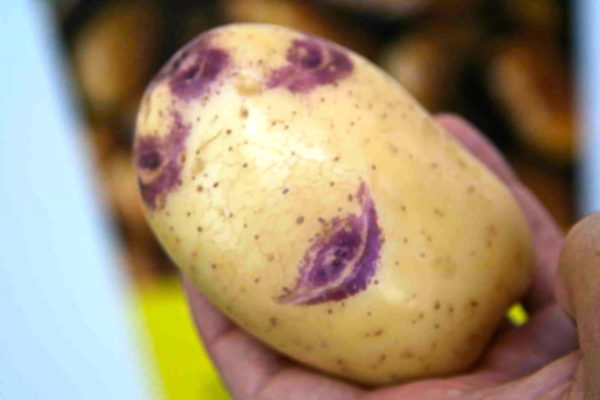
The Sineglazka potato variety has been popular for many years among summer residents and rural residents. This variety was bred in the postwar years by breeder S.I. Domin. Potatoes of this variety were not suitable for industrial cultivation. However, due to its unpretentiousness and excellent taste, Sineglazka is able to compete with many new varieties of potatoes.Sineglazka potatoes are used to prepare a wide variety of dishes. The plant forms powerful bushes, with dark green foliage. Potato of this variety blooms for a long time, in blue flowers, practically does not form berries.
Content
Description and specifications
The variety is mid-season, beige tubers with purple eyes. The shape of the potatoes is oval-oblong, the skin is smooth. The cut flesh is white, with a starch content of up to 15.5%. The average weight of a tuber is from 150 to 200 grams. The variety is quite productive, with one hundred parts you can get up to 500 kg of tubers.
The variety has a long growing season. Tubers are formed in the correct form, almost the same size. As a rule, the crop of this variety is concentrated in the hole and does not extend beyond it.
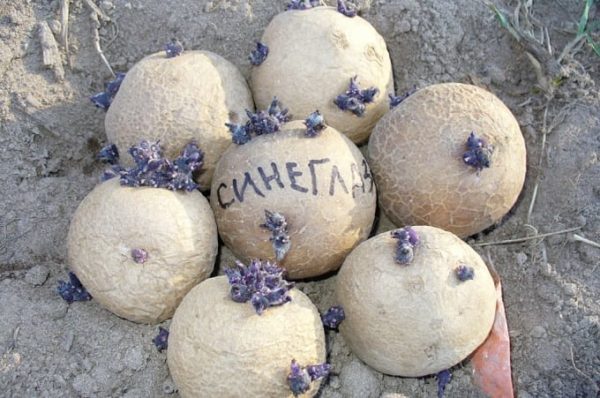
The blue eye is resistant to diseases such as scab, nematode, potato cancer, a variety of viruses. Once every 4-5 years, the seed material must be updated. If this is not done, the potato degenerates and productivity decreases.
Grade Advantages
The main advantages of this variety are good productivity and excellent taste. Sineglazka potatoes are also well stored in private cellars, resistant to a number of diseases and undemanding in care. The tubers of the variety contain a lot of vitamin B, C and potassium zinc, manganese.
Variety disadvantages
Potatoes of this variety are not suitable for industrial cultivation, as they are demanding on storage conditions. Every few years, root crops become smaller, the quantity and quality of the crop suffers. Therefore, every few years it is required to update the seed. The blue eye is unstable to late blight, and therefore requires additional protective measures.
Preparing seed potatoes for planting
Germination. In early April, potatoes intended for planting are brought into a warm room for germination. In this case, the air temperature should be from +18 to +20 degrees. Tubers are sorted, if there are signs of potato disease, removed. Samples with weak filamentous sprouts should also be excluded.
Seed tubers are laid out in boxes or on burlap in one or a maximum of two layers. If there is not enough space, then for the germination of potatoes, you can use nets, transparent bags with holes for air circulation. After a few days, the temperature is reduced to +10 or + 14 degrees. This technique helps to form strong sprouts and does not allow them to stretch.

It so happens that the tubers germinate quickly, and the time for planting has not yet come, in this case, the sprouts gently break off without damaging the eyes. This procedure can be carried out twice, with the advent of the third sprout, potatoes must be planted.
Another condition for the appearance of potato sprouts is humidity in the room. Optimum humidity indicators from 80 to 85%.If the air in the room is dry, then the seeds are sprayed with water several times a day or water containers are placed nearby. After about 30 days, the potato sprouts, by the time of planting, the sprouts should reach from 1-1.5 cm.
Treatment. Before planting the tubers are treated with copper sulfate, this is a good prevention against many diseases. To do this, prepare a solution, use 1 tsp of the substance for three liters of water, mix everything thoroughly and spray the potatoes or place it in the solution for 1 minute. After five days, seed tubers can be treated with a fertilizer solution or growth stimulator.
A nutrient solution is prepared as follows: 1 tbsp. Is dissolved in 10 liters of water. l ammonium nitrate and 1 tbsp superphosphate. On the day of planting, the tubers are dipped for an hour in a nutrient solution, and then they are dried in the open air. Thus, the tubers receive additional nutrition, which helps to activate all the important chemical processes for the growth and development of the plant.
How to cut tubers properly. Cut tubers is necessary only if the planting material is too small or as an option for rapid propagation of the desired variety. In these cases, the middle tubers are divided into two halves, large into 3-4 parts. Experts recommend cutting potatoes 7-10 days before planting, so that a protective layer appears on the cut. If there is a need to cut tubers on the day of planting, they should be treated with the drug "Maxim" or "Sinclair", Celest-Top "," Switch ".
Landing
"Sineglazka" planted in late April or from May 1 to 9. The site is selected open sunny, with light fertile soil, not flooded during the flood season. Digging a plot for planting potatoes, you can add nitrogen-containing fertilizers to the soil. The seed placement depth is 10 cm, the distance between them should be at least 35-40 cm. A distance of 60-70 cm is maintained between the rows.
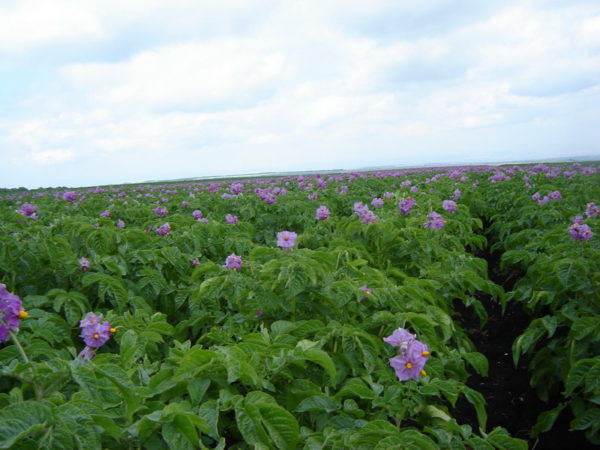
Care
Watering. Water stagnation must not be allowed, and a lack of moisture also affects the crop negatively. Mandatory watering of plants is necessary in the following periods:
- after the appearance of sprouts;
- during budding;
- after flowering has ended.
If there is severe drought and the soil begins to crack, and the potato bushes look wilted, watering is necessary. For normal hydration of potato plantings, 40 liters of water per 1 m² are used.
Hilling and cultivation. Sineglazka potatoes are grown twice during growth. The first hilling is carried out when the tops have grown by 15-20 cm. In this case, the soil is raked from the row-spacing to the stem of the bush. The following hilling is performed after two weeks. Loosening the soil is better after rain or watering. And so that the moisture does not evaporate so quickly, the aisles are mulched with hay, straw or fresh grass.
Top dressing
If during digging the soil before planting, nitrogen fertilizer was applied, then in the first phase of growth, Sineglazka can not be fed. In the second period of growth, plants need organic top dressing. To do this, use rotted manure at the rate of 5 kg per 10 m². Organic fertilizer is applied after precipitation, before hilling.
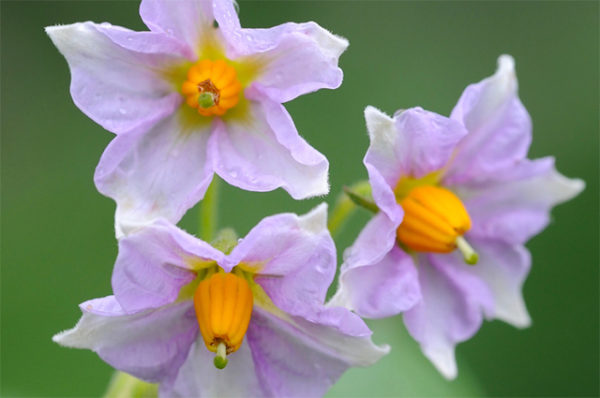
Common diseases
Phomosis. Signs of the disease can be seen during flowering. At the beginning of the leaf petiole an elongated spot forms, which then passes to the stem. Sick stems die off, spores of the fungus fall on the tubers. Rounded dark spots are visible on affected potatoes. Such a crop is not stored. For the processing of young shoots, use Shirlan or Thanos.Before flowering, potato plantings are treated with fungicide "Ridomil Gold MC"
Virus twisting. The color of the leaf changes, its upper side turns yellow, and the lower becomes pink. Further, the leaves curl along the central vein, acquiring the shape of a boat. The sheet becomes hard and breaks when touched. This disease is not treated with drugs. The infected plants are dug up and burned outside the garden.
Striped mosaic. The disease manifests itself during the period of budding. On the lower leaves, you can see dead tissue, gradually the necrosis passes to the entire leaf and petiole. Over time, all the leaves fall, the bush cannot grow and develop normally. Crop loss in this disease can be up to 90%. The disease is not treatable, so the bushes along with the tubers are destroyed.
Pests
Potato Moth. Clutch of eggs of this insect can be found on the inner side of the leaf near the petiole. Soon, caterpillars appear on them, which feed on leaves and root crops closer to the surface of the earth. Damaged potatoes begin to rot. Potato moths can be caught in pheromone traps. If the caterpillars have already appeared, the plants are treated with Cytokor or Spark. Two weeks before harvesting, Bitoxibacillin is used.
Wireworm. This is the name of the nutcracker beetle larva, which gnaws the moves in potatoes. Damaged crops are not stored. When landing in the hole add Bazudin or Pochin. The site is dug up in late autumn so that the larvae appear on the surface and die from the cold. And also we must not allow the presence of weed grass, especially wheatgrass. Marigolds are planted next to potatoes, which repel the nutcrackers with their smell.
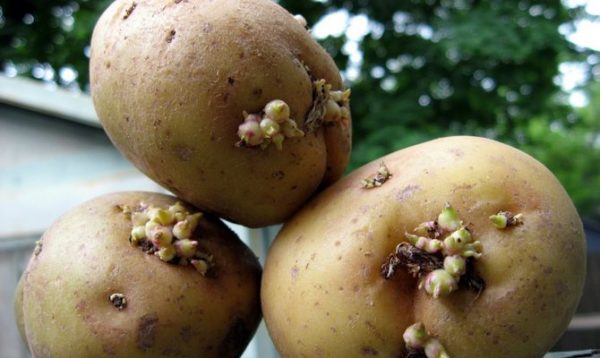
Colorado beetle. The larvae of this insect can destroy plantings in a matter of days. In order not to lose the crop, the plants are sprayed with the preparations “Masterpiece” or “Prestige”, “Batsikol”, “Dendrobatsilin”.
When to dig and how to keep the crop
"Sineglazka" begins to ripen in July, but for long-term storage, the tubers are dug in late August or early September. It is important that dry sunny weather be on these days. The dug potatoes must surely dry well, after which it can be removed for storage. Damaged tubers or with signs of disease should not be allowed to bookmark for the winter. Store the potato crop in a cool room at a temperature of + 2 degrees and a humidity of 80%. Tubers are poured into wooden boxes or boxes, cloth bags.
Reviews
Maxim 32 years:
“My grandfather cultivated the Sineglazka potato variety; potatoes were always large. Last year, he decided to try to plant this variety. They began to dig up the crop in mid-July, the tubers were medium in size, with thin skin. At the end of August, he dug up the remaining crop. From one hundred square meters I’ve collected 450 kg, I’m satisfied with the result. ”
Michael 47 years old:
“I plant the blue eye for the third season, the potatoes are delicious. There are practically no problems with growing, only periodically we fight with the Colorado potato beetle. I keep the harvest in the cellar in wooden boxes, the potatoes are well stored until spring. "
Anna 54 years old:
“A neighbor shared the seeds of this variety. In the first year, two Sineglazka buckets were planted with her husband. Gardens with potatoes were watered twice, during the summer on especially hot days. Very happy with the harvest, the tubers are large, sometimes medium ones were found, there were almost no small potatoes. This year we will already grow Sineglazka from our seeds. ”




 Description and description of varieties in Belarus with a photo
Description and description of varieties in Belarus with a photo Do I need to pick flowers from potatoes: why do they do it
Do I need to pick flowers from potatoes: why do they do it When to dig potatoes: timing and availability of new potatoes
When to dig potatoes: timing and availability of new potatoes How to grow a good potato crop: various methods and methods, planting and care
How to grow a good potato crop: various methods and methods, planting and care